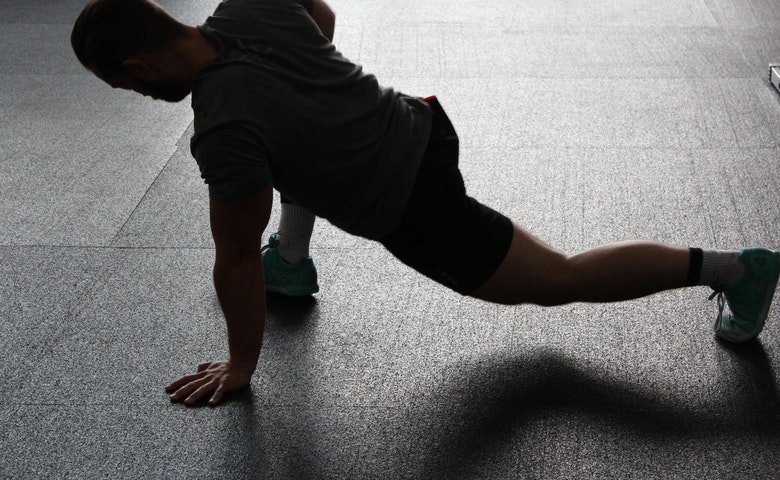It can be tempting to jump right into an intense workout, but like a car on a cold day, the body needs a pre-workout routine for peak performance. Pre-workout stretches are essential for a safer and more effective workout routine. Some of the benefits include:
- Improved blood circulation increases nutrient and oxygen transportation.
- Improved flexibility for a better range of motion that allows a more efficient workout with better form.
- Improved muscle strength, speed, and agility
- Improved balance and posture
- Reduced risk of injury, muscle tension, and fatigue
5 Pre-workout Stretches
Here are 5 categories of pre-workout stretches that help target major muscles groups and make a fitness routine more efficient. It is best to perform these stretches at a relaxed, slow, and steady pace. Rushing can lead to bad form, improper breathing, strained muscles, and injury. Based on the body’s response, it is ok to modify the stretches into more simplified versions.
1. Ham String Stretch
Tight hamstrings are often responsible for lower back pain and tight hips. Hamstring stretches reduce the strain on the back and prevent pulled hamstrings.
Start by standing with the feet shoulder-width apart while keeping the knees bent slightly. Next, slowly reach down and try to touch the toes with the hands. The goal is to feel the hamstrings stretching, even if it is only a light stretch. Only reach down as far as the body will permit to prevent strain and muscle injury. Hold the position for a few seconds, release, and then repeat 5-10 times.
2. Calf Stretch
The calves stabilize the body during exercise and everyday activities, such as walking. Strong calf muscles allow for a more efficient and strengthening workout, while weak calf muscles can lead to fatigue, pain, and even injury.
To stretch the calves, first stand on something elevated, such as a curb. When standing, stand with the heels hanging off of the edge. Next, slowly raise the calves and hold the stretch before lowering the calves back to the ground at a slow pace.
3. Hip Rotator Stretch
Tight hips can cause pain and discomfort in both the back and legs. A job that requires sitting for long periods can weaken the hip adductor and abductor muscles and cause balance issues. Hip rotations help loosen the hips for better balance and range of motion.
Start in a standing position and then lift one knee to the chest. Next, move the knee slowly away from the body before lowering the raised leg back to the ground. The knee should make a circular motion in the air as the legs make their way back to the ground. Perform 10 to 20 rotations and then switch legs.
4. Bicep/Triceps Stretches
Arm stretches are essential for a proper upper body workout. Stretching before weightlifting, for example, helps the muscles in the arms work more efficiently and become less prone to injury.
Bicep Wall Stretch
To do this stretch, find a wall or pole. Next, place one hand on the wall and then slowly turn away from the wall. To target other parts of the bicep, adjust the hands to a higher or lower position on the wall.
Triceps Shoulder Stretch
First, raise one arm above the head. Next, bend the raised arm at the elbow. Then, gently push down on the elbow using the other hand. Do this stretch in a slow, easy motion to avoid stress and strain.
5. Back Stretch
The back serves as a connector for the rest of the body. A stiff back can lead to a host of other problems such as tight shoulders, a stiff neck, and tight hips.
Cat-cow stretch
This easy stretch helps increases back and spine mobility. First, get on all fours in a tabletop position. Then, look up and invert the spine into a dip, pushing the belly towards the ground. Next, tuck the chin and then arch the back toward the ceiling. Cycle back and forth between the two movements while inhaling and exhaling.
Ladder Climb Stretch
The spine takes a lot of stress during a workout. Mimicking the motion of climbing a ladder helps condition the spine by engaging it in a side-to-side motion. This stretch also helps strengthen the back in general.
First, stand up and reach arms high up. Then, reach up the “ladder” one arm at a time in an alternating fashion. The goal is to reach up as high as possible while only moving the shoulders and spine. Perform 10-20 ladder reaches with each arm at a slow and steady pace.
Other Helpful Pre-workout Tips
Cardio Warmup
5-10 minutes of light cardio before stretching increases the heart rate and blood supply gradually. Examples of light cardio include jogging, jumping jacks, and jumping rope. These cardio exercises don’t need to be very intense. The main goal is to warm up the body and prepare the major muscles groups for stretching and a more intense workout.
Proper Diet
Just like a car needs a source of energy to run, the body also needs fuel to perform at optimum levels. A diet rich in healthy carbohydrates, fats, and antioxidants is essential to a fitness regimen. The American Heart Association recommends eating healthy carbohydrates such as whole-grain cereals, toast, brown rice, and vegetables about an hour ahead of working out. Fast-burning carbohydrates, such as those found in bananas, can be eaten 10-15 minutes before working out.
Adequate Hydration
Dehydration can make muscles less stiff and more prone to strains, cramps, and injury. In addition, dehydration can also cause cognitive decline and reduced performance. Adequate hydration at all points of a workout is crucial to a safe and effective routine. Make sure that you support your exercise with a pre-workout supplement, and re-energize your body afterwards.



